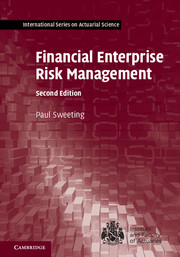Book contents
- Frontmatter
- Contents
- Preface
- 1 An Introduction to Enterprise Risk Management
- 2 Types of Financial Institution
- 3 Stakeholders
- 4 The Internal Environment
- 5 The External Environment
- 6 Process Overview
- 7 Definitions of Risk
- 8 Risk Identification
- 9 Some Useful Statistics
- 10 Statistical Distributions
- 11 Modelling Techniques
- 12 Extreme Value Theory
- 13 Modelling Time Series
- 14 Quantifying Particular Risks
- 15 Risk Assessment
- 16 Responses to Risk
- 17 Continuous Considerations
- 18 Economic Capital
- 19 Risk Frameworks
- 20 Case Studies
- 21 Solutions to Questions
- References
- Index
21 - Solutions to Questions
Published online by Cambridge University Press: 12 August 2017
- Frontmatter
- Contents
- Preface
- 1 An Introduction to Enterprise Risk Management
- 2 Types of Financial Institution
- 3 Stakeholders
- 4 The Internal Environment
- 5 The External Environment
- 6 Process Overview
- 7 Definitions of Risk
- 8 Risk Identification
- 9 Some Useful Statistics
- 10 Statistical Distributions
- 11 Modelling Techniques
- 12 Extreme Value Theory
- 13 Modelling Time Series
- 14 Quantifying Particular Risks
- 15 Risk Assessment
- 16 Responses to Risk
- 17 Continuous Considerations
- 18 Economic Capital
- 19 Risk Frameworks
- 20 Case Studies
- 21 Solutions to Questions
- References
- Index
Summary
Chapter 1
1. Risk management can reduce the volatility of the firm's earnings. This could increase the value of the firm by reducing the risk of bankruptcy or tax liability. It could also improve the firm's credit rating, and reduce the risk of regulatory interference. The reduced volatility in earnings could also help to avoid large swings in the number of employees required. In addition, it could reduce the risk capital required, thus increasing returns on capital.
2. ERM can help to ensure that all risks are covered, and covered consistently in terms of the way they are identified, reported and treated. ERM also involves the recognition of concentrations and diversifications arising from the interactions between risks. This offers a better chance of the overall risk level being consistent with an organisation's risk appetite. It also allows a more accurate calculation of the required risk capital. In addition, it helps firms react more quickly to emerging risks, and to prioritise the various risks arising from various areas of an organisation. It can also reduce the costs of risk responses if carried out across a firm as a whole, and it can ensure that responses are consistent. Finally, ERM might be required by an industry regulator, or by a firm's auditors or investors.
3. The chief executive is responsible for running the firm whilst the chairman is responsible for running the board. As such, the chairman is responsible for the oversight of the chief executive. European regulations (CRD IV and MiFID) require financial firms to be controlled by at least two individuals. There are also restrictions on combining the roles of chairman and chief executive in CRD IV. However, having an executive chairman ensures consistency between the derivation of a strategy and its implementation.
4. The approaches are:
• three lines of defence;
• offence and defence;
• policy and policing; and
• partnership.
Chapter 2
1. The original role of investment banks was to raise debt and equity funds for customers, and to advise on corporate actions such as mergers and acquisitions. In addition, investment banks now buy and sell securities and derivatives.
2. ‘Long-term’ can be used to refer to a particular type of policy. A long-term insurance policy is one that is in place for a long time.
- Type
- Chapter
- Information
- Financial Enterprise Risk Management , pp. 552 - 572Publisher: Cambridge University PressPrint publication year: 2017



